Designed for a sustainable life and for not having the car ‘on your back’, Arcosanti is a fascinating urban experiment that in 2020 celebrates fifty years of life.
The Museo del Camminare has investigated the reasons for its pedestrian character and, thanks to Hanne Sue Kirsch of Archives at Arcosanti, presents a written and visual account of its outstanding history.
Read MoreNothing emerges from the published writings of the Italian architect and founder of Arcosanti Paolo Soleri that sheds light on his appreciation of the urban character of Venice, though he visited the city several times and held a series of planning workshops at the local IUAV University of Architecture in 2003 and 2004. However, several arguments can be put forward to consider Venice a possible inspiration for the planning of an “arcological” city. When Soleri created the concept of Arcology at the end of the 1960s by combining architecture and ecology, he thought of a city ‘coherent’, ‘meaningful’, ‘ecological’, ‘tri-dimensional’, and ‘lovable’.1 By stressing the need to render our habitat on a human scale and to turn the city into a means of civilisation through socialisation and culture, Soleri explicitly acknowledged the influence of the historic Italian cities and their tradition of humanity as groups of people who have a great interest in their life and possess the Homo sapiens’ most benevolent characters.2 With its around 2,000 acres, the land area of Venice’s historic centre provides that socio-cultural density and compactness which Soleri theorised to be intrinsically beneficial to the urban environment, and which served as inspiration for his planning and building of Arcosanti, the experimental town that Soleri founded in 1970 on a 860-acre site in the Arizona desert. For Soleri, this concept of city functioned as a remedy against the urban ‘metastasis’ affecting the U.S. cities – the suburbia and megalopolis characterised by ‘bigness, flatness, isolation, logistical crippling, land destruction, soil decay, aquifer degradation, quarantine of forests, pollution, and, inevitably, materialism’.3
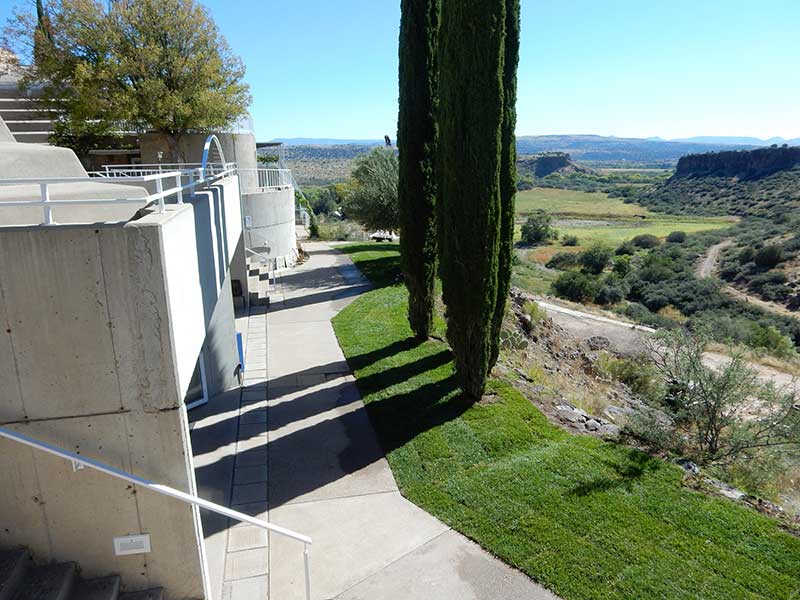
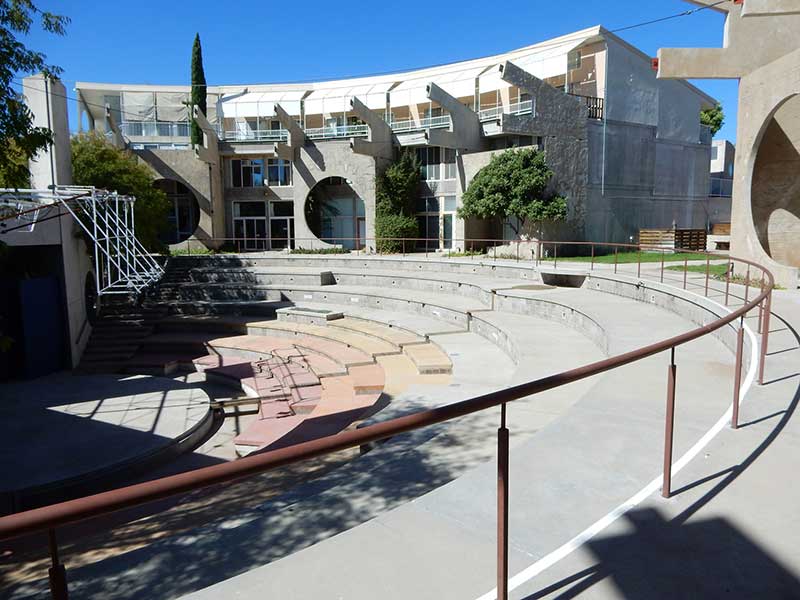
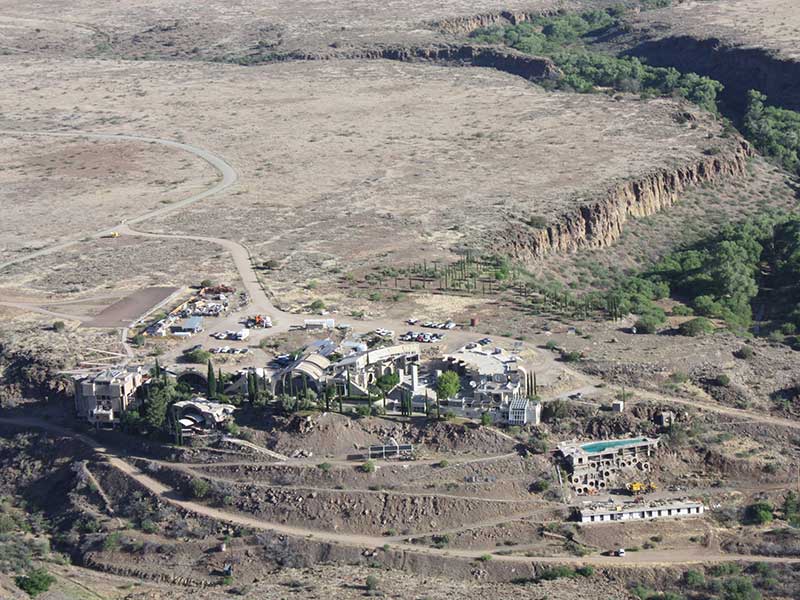
According to Soleri, urban streets and roads have to play the same role that the life-giving and cleansing reticulum of arteries and veins constantly does when serving the flesh. In Arcosanti, this took the form of a network of footpaths linking dwellings, public buildings, and public spaces. The veins and arteries metaphor is particularly appropriate in the case of Venice, the street system of which Le Corbusier had described as a ‘pure cardiac system, impeccable’. According to Le Corbusier, Venice benefits of the separation of pedestrian and vehicle traffic, a system in which ’the pedestrian is the king; he has never lost his dignity’, and that brings ‘quiet and joy’ to the residents.4 Both Venice and Arcosanti, in fact, are car-free environments, an aspect that is central in Soleri’s concept of Arcology and that stems from his fierce criticism against what he called the ‘automobile-industrial-financial complex’ and its catastrophic consequences.5 All Soleri’s urban plans – Mesa City, Arcosanti, Lean Linear Arterial City – respond to the urge he felt to reverse the car-centred logic of the North-American society, a logic that he considered as the ‘terrible indictment of the sterility, grossness, and cruelty of our civilization’.6 Referring to the U.S. situation, Soleri pointed out how the car and the man’s subjugation to it divide people and things by promoting the urban sprawl, contribute to pollution and inefficient use of resources and energy, and entail tens of thousand deaths and countless physical and mental damages per year.7 He believed that even the diffusion of electric vehicles will not solve the problem, but will worsen it, as the number of cars will increase, and the car is ‘pollution by itself’.8 The marginalisation of the car, according to Soleri, is a ‘necessary step toward the implosion of our presence on the planet’.9 Arcosanti has no streets and this is not because of the small size of the settlement – as Soleri explained –, but because ‘the notion is that: you want not to have the car on your back, don’t build streets’.10
On the opposite sides of the Atlantic Ocean, whether in the middle of the water or in the desert, the historic city of Venice and the relatively recent experimental micro-city of Arcosanti tell the world that a carless urban civilisation is possible, in which living is sustainable and ‘distances are measured again by walks and in minutes’.11
‘As urban architecture, Arcosanti is probably the most important experiment undertaken in our life time.’ — Douglas Davis, Newsweek, 1976
The Arcosanti Project is being developed by the Cosanti Foundation, a non-profit educational organization dedicated to the investigation of new urban patterns. The Arcosanti Project addresses the environmental, social and cultural issues faced by an increasingly urbanizing and global civilization. Arcosanti will develop and demonstrate a sustainable urban system on marginal land in the American southwest.
Arcosanti is intended as a prototype arcology, a compact, three dimensional framework in which to develop a town which is urban in character and which consumes only a fraction of the land required by a conventional town of comparable population. The Arcosanti Project is planned as a town for 5,000 people developed as an urban environment encompassing a 20 acre site within an 860 acre land sanctuary located in central Arizona. Arcosanti will provide a pedestrian environment, in which automobiles are excluded from the townscape. Arcosanti would define a new relationship between city and country, a compact, lively urban habitat within a vast natural landscape.
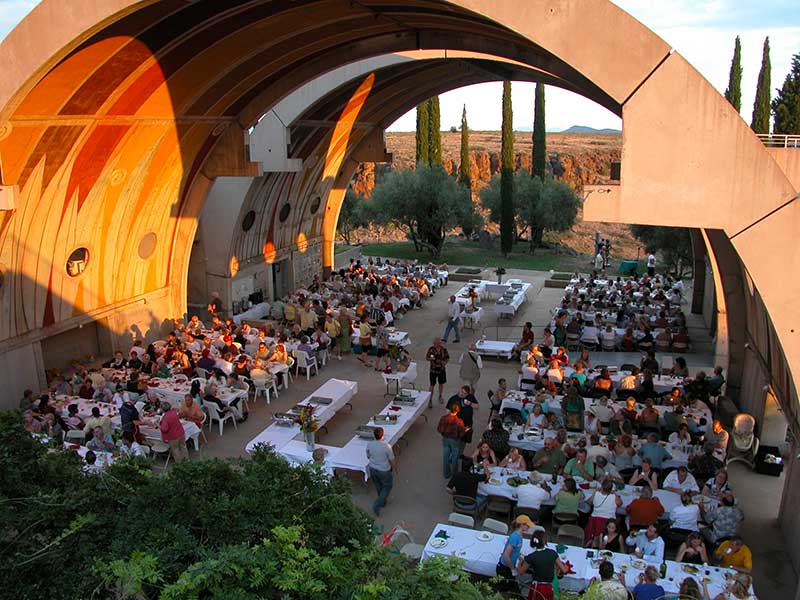
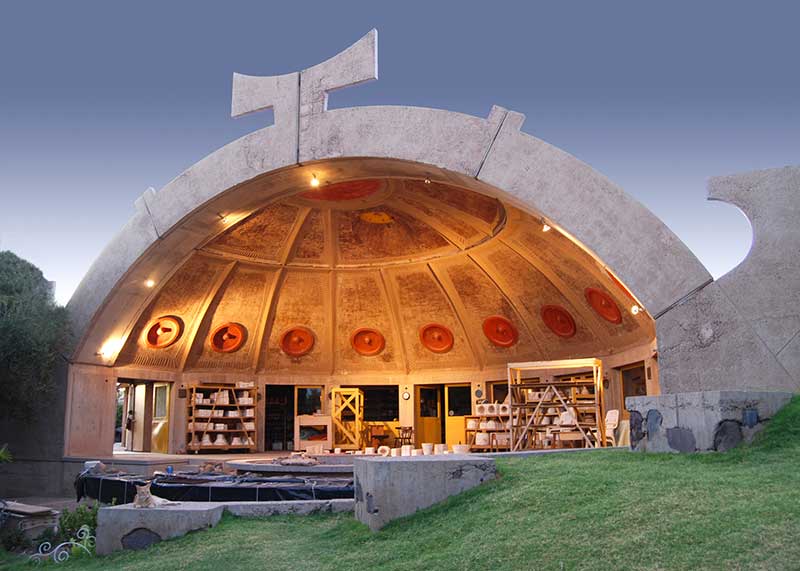

The site on which Arcosanti is being constructed was chosen for its rural character in the high desert mesa and canyon topography of central Arizona as well as for its proximity to a major interstate highway. The major geographic feature of the Arcosanti’s 860 acre land sanctuary is a riparian canyon containing the Agua Fria River, assuring a year round water supply. This 860 acres owned by the Cosanti Foundation is bounded on the east and west by two parcels leased from the State of Arizona totaling 3,200 acres; Arcosanti thus sits within a 4,000 acre property most of which is intended as open space element.
Arcosanti’s design is intended as an experimental demonstration of design innovation and construction techniques. A primary innovative construction technique is the use of silt as a casting medium for concrete construction. A primary design element in the Arcosanti master plan is the apse form, a quarter sphere structure oriented to the south so as to relate to the sun’s annual path across the sky.
Design Principles
Arcosanti seeks to embody a ‘Lean Alternative’ to hyper consumption through a smartly efficient and elegant city design. Leanness is inherent to the sustainable health of any living system. The city needs to be such a system. The following principles foster miniaturization (compact optimization) resulting in complexity. Together they manifest an urban system that can function as a hyper-organism.
PROXIMITY (24/7 Mixed-use Continuum)
Arcosanti’s design provides an efficient and lively urban environment by physically connecting a mix of activities such as living, working, learning and leisure. In this way efficient and equitable access to most of the city’s amenities and are available within minutes. Although life in such a setting will be intense and exciting, at times it could be taxing on individuals. For this reason, Arcosanti also features immediate access to open space and nature, to provide opportunities to decompress.
Richness in life may be measured not by possessing ‘more’ materials as individuals, but rather by requiring ‘less’ materials through a more fully shared and higher quality environment.
URBAN-HUMAN SCALE (Pedestrian Environment)
Human scale is generally recognized as physical proportion that we can personally relate to. Urban scale results from having a densely organized human environment. However, when dense and efficient urban spatial arrangements are adopted for pedestrian (and cyclist) mobility, such robust three-dimensional living can become human scale once again.
Eliminating automobiles from the city core can lead to an environment that is less polluting and wasteful, and healthier overall for urban residents.
ECOLOGICAL ENVELOPE (Bounded Density)
A major tenet of Arcology requires that in order to sustain the health of a city, we define the ecological envelope as the carrying capacity of the environment containing our human activities. Opposed to sprawling development, the Arcosanti project means to “interiorize” itself by designing an urban condition with strict boundaries.
‘Growth within limits’ is the inward developmental mindset necessary to reduce our ecological footprint.
LESS CONSUMPTION (Embodied Efficiency)
By applying appropriate technologies such as passive climate control systems, innovative water/sewage treatment systems, and using proper green building materials and recycling technology, we can certainly increase the ‘lean’ factors in our project, as long as the effort results in less material and energy consumption within the community.
A reduction in material and energy waste can be achieved not only by technological innovations, but also by how we organize ourselves and our relationship to the earth.
ENERGY APRON (Energy and Food Nexus)
Urban agriculture reduces our ecological footprint by bringing food production closer to the habitat where consumption occurs. In addition to open field cultivation, a terraced greenhouse, Arcosanti’s Energy Apron [planned], is intended to extend the growing season and provide diversified crops within its stratified micro-climate conditions. This glazed productive environment substantially reduces the amount of water required to grow food and, in addition, provides rainwater reclamation opportunities, while diverting excess heat to upper structures for space heating when needed.
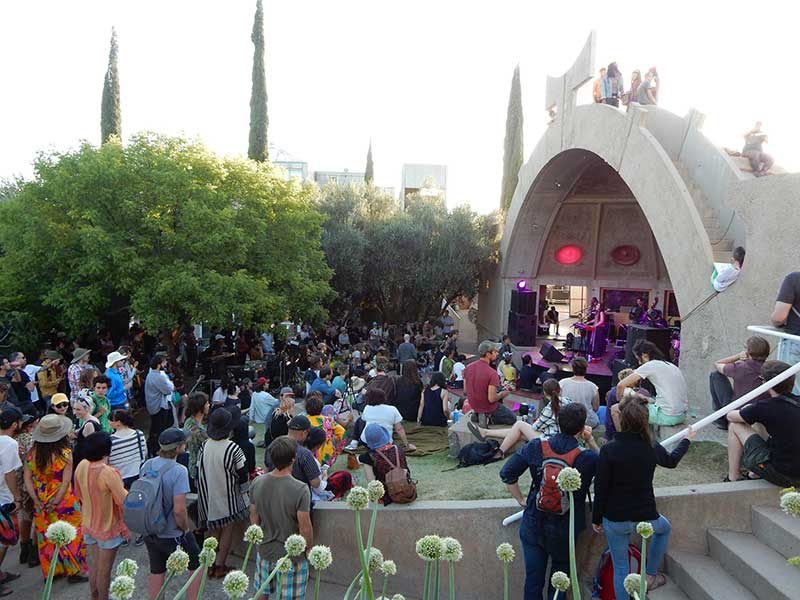

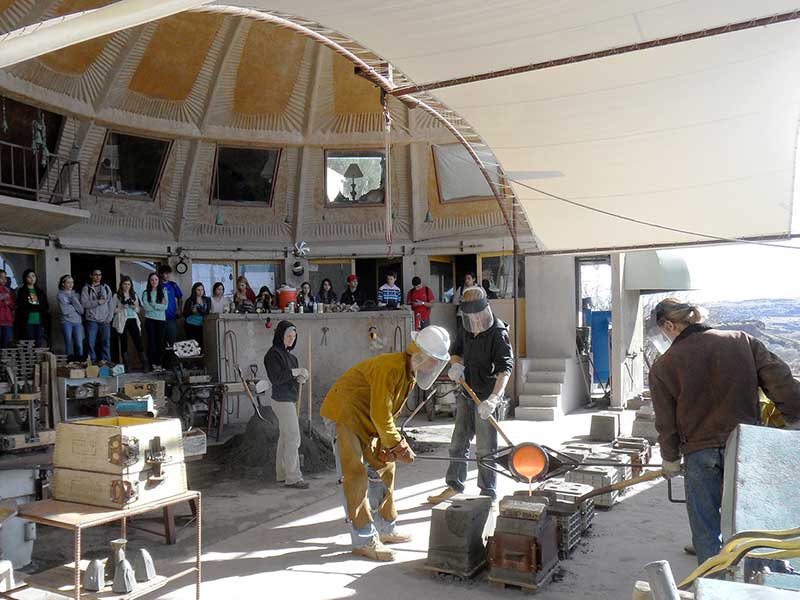
Arcosanti also actively seeks less polluting renewable energy production systems such as solar, wind and other systems in place of hydrocarbon and nuclear based energy sources.
In 1970, the Cosanti Foundation began building Arcosanti, an experimental town in the high desert of Arizona, 70 miles north of metropolitan Phoenix. A dozen buildings used for current activities occupy a small fraction of the full 860 acres of Arcosanti property. Construction was done entirely by workshop participants, volunteers and a small rotating staff of professionals over the years. Close to 8,000 people participated and the workshop program is continuing to present day.
Cover image: Paolo Soleri, Macro Cosanti, 1964 (detail).
Images: courtesy Cosanti Foundation - Archives at Arcosanti
1. Soleri, Paolo, Arcology. The City in the Image of Man, Cambridge (Mass.), MIT, 1969, digital edition URL: http://www.organism.earth/library/document/76
2. Zanchi, Flores, Interview with Paolo Soleri, URL: https://www.youtube.com/watch?v=LQ9OSXyrZ00
3. Soleri, Paolo, Conversations with Paolo Soleri, edited by Lissa McCullough, New York Princeton Architectural Press, 2012, p. 39.
4. Le Corbusier, ‘Je prends Venise à Témoin’, in Id., La Ville Radieuse, Boulogne-sur-Seine, Architecture d'Aujourd'hui, 1935, p. 268.
5. Soleri, Paolo, Conversations with Paolo Soleri, op. cit., p. 68.
6. Soleri, Paolo, Arcology. The City in the Image of Man, op. cit.
7. Soleri, Paolo, Conversations with Paolo Soleri, op. cit., p. 86.
8. Piedmont-Palladino, Susan, Lessons in Arcology. An Interview with Paolo Soleri, 31 October 2006, URL: http://www.nbm.org/lessons-arcology-interview-paolo-soleri/
9. Soleri, Paolo, Arcology. The City in the Image of Man, op. cit.; Soleri, Paolo, Conversations with Paolo Soleri, op. cit., p. 86.
10. Dirksen, Kirsten, Arcosanti: Paolo Soleri on his futuristic utopian city in AZ desert, interview with Paolo Soleri, Arcosanti, 2000, URL: https://www.youtube.com/watch?v=VICOY_CVaHs
11. Soleri, Paolo, Arcology. The City in the Image of Man, op. cit.
© Museo del Camminare 2019, licensed under Creative Commons CC BY-NC-ND 4.0